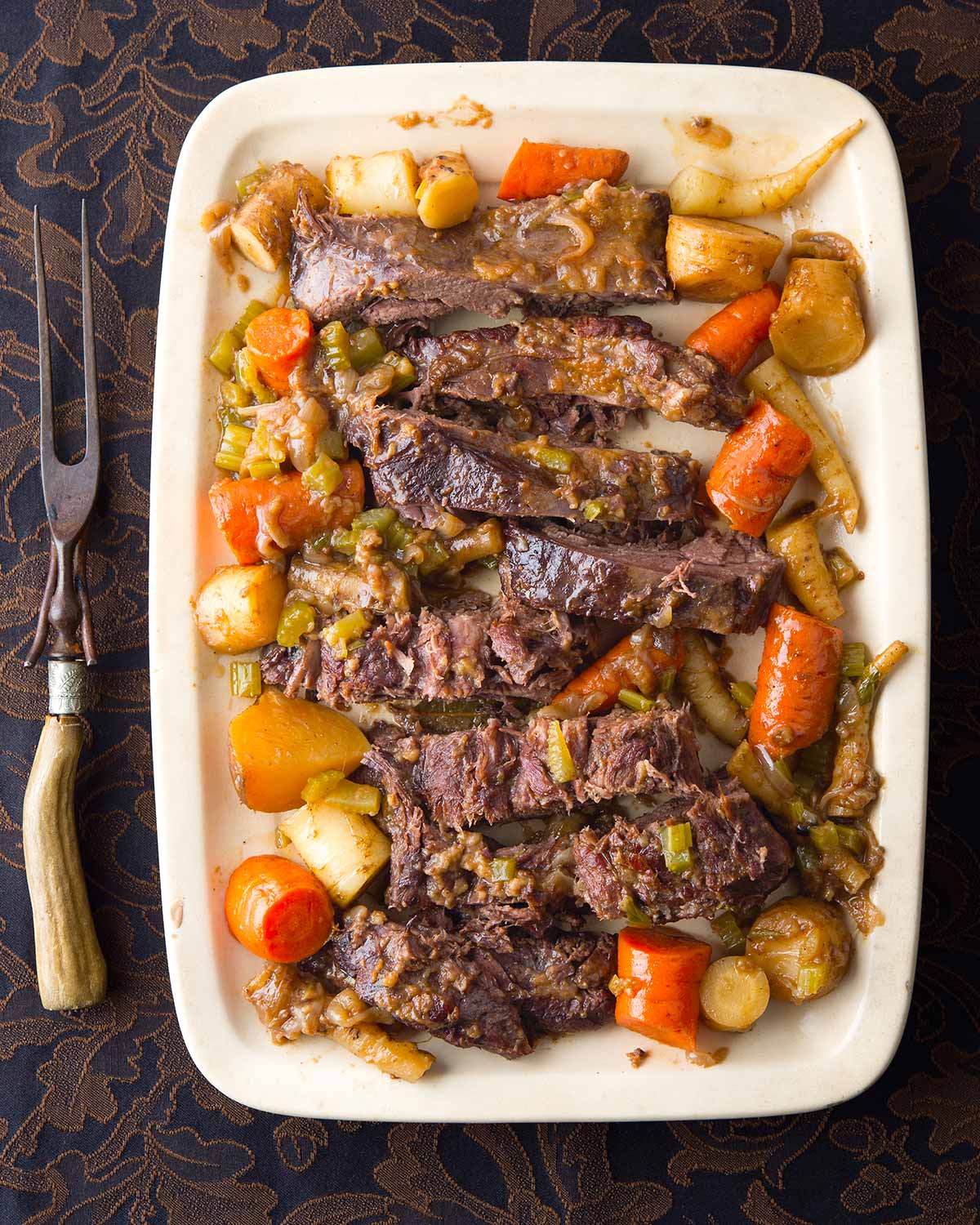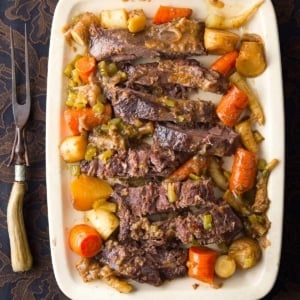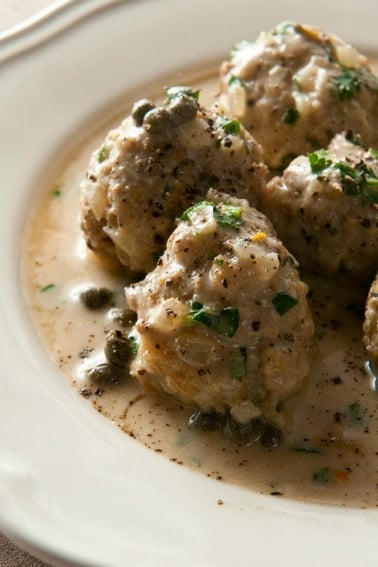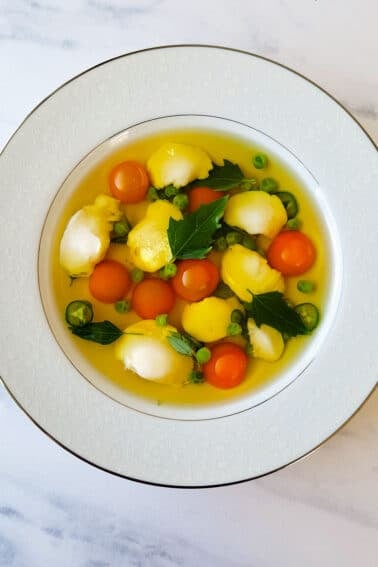As an Amazon Associate I earn from qualifying purchases.
I have a lot of venison recipes that work well with a Crock Pot or slow cooker, but this venison pot roast is actually designed for one.
What you see is my version of the good ole’ pot roast pretty much everyone ate while growing up. What makes it Polish? Only that I found a similar recipe in a book called Polish Heritage Cookery by Robert and Maria Strybel. I like the use of flour and paprika, and the overnight wine marinade, each of which add a layer of flavor to the final dish.

A venison pot roast is a bit different from the classic Jewish pot roast I ate as a kid. That pot roast was always made with beef brisket, a luscious, fatty cut that lends itself to slow and low cooking. Just ask the Texans about that one. Try to make a pot roast from a deer, elk or moose brisket and you’ll run up against its leanness. It will still be OK, but lack that lush texture of beef brisket.
And if you try to make a venison pot roast with a hind leg roast you will be super sad. Why? No internal fat, not enough connective tissue. It’ll be dry as hell. Really unpleasant. Hind leg roasts are best done as single-muscle roasts, ideally smoked, and cooked to a finishing internal temperature of about 135°F, which is medium-rare.
Nope, you need another cut for a good deer pot roast. And the best cut of all is the neck. Yes, you read that right. Either pot roasted whole and bone-in, which I do for smaller animals, or cooked as a boneless venison neck roast, which I do for elk. You will find that this is the finest cut for slow, low, moist cooking.
Why? Because a neck is the opposite of a hind leg roast. It’s loaded with connective tissue. And in the absence of internal fat, connective tissue, which melts when cooked slowly under moist conditions, provides that luxurious texture you want in a good pot roast.
Other good candidates for pot roast are whole deer shoulders, big shoulder roasts from larger animals, or shanks. All have lots of connective tissue. I have a cool deer shoulder pot roast recipe here.
I prefer bone-in venison pot roasts for the most part, but then I don’t live in an area with chronic wasting disease. If you do, bone out the neck. It is true that CWD has never crossed the species barrier to humans, but better safe than sorry. Ditto for the shoulder.
You will see in the instructions that I don’t use a Crock Pot or slow cooker, largely because I work from home and can monitor a slow-cooking pot roast all day. If you use a Crock Pot, you will need to brown the meat and onions before you put things into your slow cooker. Once everything is all settled into the pot, turn it on “high” and your slow cooker will do its thing all day while you are at work.
Crock Pot Venison Roast
If you are using an Instant Pot or a similar pressure cooker for venison pot roast, you will want to set it for about 80 minutes, more or less. Since it is wild game, cooking times will vary, but that should get you close.
One important thing to remember, whether you are using a Crock Pot, Instant Pot or are cooking things normally, is that it takes time for a venison pot roast to get tender. Tough meat is simply not ready yet: Period, end of story. Keep cooking it.
Needless to say my choice of root vegetables is my own. Feel free to play with it to suit your own tastes. Just remember: Don’t skimp on the marinating time or on the onions. They make a big difference.
Venison Pot Roast, Polish Style
Ingredients
- 1 bottle of red wine
- 6 to 10 allspice berries, cracked
- 6 to 10 black peppercorns, cracked
- 3 bay leaves
- A 2 ½ to 4 pound neck roast, boned or bone-in
- Salt
- 1 cup flour
- 3 tablespoons paprika
- 1 tablespoon cayenne (optional)
- ¼ cup lard, bacon fat or cooking oil
- 2 onions, sliced root to tip
- 2 celery stalks, diced
- 3 carrots, cut into large chunks
- 2 parsnips, cut into large chunks
- 3 Yukon Gold potatoes, cut into chunks
- 1 rutabaga or 2 turnips, peeled and cut into chunks
- Black pepper to taste
- Sour cream, for garnish
Instructions
- Bring the wine, allspice, black peppercorns and bay leaves to a boil. Turn off the heat and let the marinade cool to room temperature. When it’s cool, submerge the venison neck in the marinade and keep in the fridge overnight, or up to 4 days.
- Mix the flour, paprika and cayenne (if using) together in a large bowl or shallow container large enough to hold the neck roast. Pat the meat dry with paper towels and salt it well. Coat it in the flour-paprika mixture. Heat the lard in a large Dutch oven or other heavy, lidded pot and brown the meat. With a typical neck roast you will need to cut it into two pieces to get it to fit the pot. Brown one piece and then remove while you brown the other. If you are using a bone-in neck, just turn the meat to brown all sides. When the meat has browned, remove it from the pot and set aside for a moment.
- Preheat the oven to 325°F. Add the sliced onions to the pot and brown them well, stirring occasionally. This should take about 8 minutes. Add 2 cups of the marinade and bring it to a boil. Add the venison back to the pot, along with 2 cups of water. Bring to a simmer, cover the pot and cook in the oven for 1 1/2 hours.
- After 1 1/2 hours have elapsed, add the root vegetables and celery and continue to cook for another 1 ½ hours, or until the meat is falling apart and the root vegetables are tender.
- Remove the meat and set on a cutting board. Slice roughly or pull the meat off the bones. Taste the sauce and add salt if it needs it. Add black pepper to taste and serve with the meat and vegetables, with a dollop of sour cream alongside.
Nutrition
Nutrition information is automatically calculated, so should only be used as an approximation.






Excellent as always, made it for Super Bowl dinner and it was loved by all!!
Hey Hank,
I’ve got ground allspice , how much do you recommend? Also going to sear and cook in a roaster. Any tips?
Matt: Maybe a teaspoon of allspice. Other than definitely covering the roaster, should be pretty much the same process.
Well done, Hank!
Don’t you dare grind that neck!
My neck roast was only 1 lb due to some field butchering mistakes as opposed to the suggested 2.5 to 4 lb roast. It could have used probably 30 minutes less, as the outer edges started to get dry, but the middle of the roast stayed moist. I flipped my roast every 45 minutes, and I’m not sure if this did anything good or bad. Pair this with a nice thick bread for sopping up that jammy onion liquid gold left over at the end.
Hey, Hank…
I love using my crock pot for dishes like this VENISON POT ROAST. How would you modify it to use with my crock pot?
Thanks,
Brian
Brian: Do all the simmering in that crockpot. After the marinade and the sear.
Hi! Back to searching your great site again after a long hiatus due to life circumstances. Always appreciate how you break things down in an understandable way for those of us learning.
If I have meat labeled deer roast but I don’t know what part of the animal it came from exactly, is there any way to identify it based on how it looks? I’m guessing not?!
so my real question- what’s best to do with ‘mystery roasts’?
It’s a younger buck, from a trip to ND, it would have fed a good bit on corn.
Currently in an urban environment, no meat smoker or grill or slow cooker right now, just a regular gas stove.
Thanks for any input!
Heather: Best way is to unwrap it and look. If it’s one large muscle, then you will want to cook it medium-rare in the center. If it’s lots of muscles, like from a shoulder, that’s pot roast material. Neck, too. Usually you can tell right away.
Hi Hank,
When using a bone-in roast for this recipe; is there any concern about the spinal cord remaining in its column during the cooking process? If you recommend it being removed, what are your suggestions for doing so? Or, should I just debone, and tie it like you suggest.
I DO NOT live in and area with CWD.
Thanks!
Matt
Matt: in your case, no worries. I debone in areas that might have CWD.
Great way to use neck (half a neck) from a big buck. Very much like a my traditional beef pot roast in texture and flavor. Seems like any combination of root vegies would be suitable. I marinated for about 18 hours and used the slow cooker method.
Delicious!
For years I’ve been telling my buddies to stop throwing their neck roasts in the grind pile, this recipe finally convinced them. Incredible.
Alright. I have made this at least 7 times now. Each time I have gotten asked for a recipe. I have shared it countless times and everyone has the same response. “I will never cook a roast any other way”. My mother who has always made roast in a crockpot and never cooks with wine is hooked.
Thank you for making me look so good.
Did this recipe in a Crockpot yesterday with 4lb bone in venison neck and I tell you what wow it was good! Followed the recipe and made the marinade 3 days in fridge used a cast iron pan to brown the meat then the onions in bacon fat added miced garlic when I browned the onions last 30 secs put those in, then I deglazed my pan with a lil bit of the marinade and Dale’s and dumped it over the roast with the onions on bottom, 8 hours low and slow but on the last 3 hours I add the root veg and potatoes and It was amazing, wife loved it! Thank you Hank!
Four days ago I returned home from my 4th WY Antelope Hunt. As we traveled across Utah I began to make plans for the frozen meat I had in my cooler. One antelope roast is always dedicated to jerky for my friends/family. I knew your list of recipes would include something special for my latest antelope and his last roast. I found this Pot Roast recipe and immediately decided it was perfect. I am typing this with a belly that is too full and I am truly amazed at how my meal turned out. Thank you for this recipe and all the others. I can think of no more suitable way to show respect to the animals we pursue than to prepare them in an honorable fashion as we sit around the supper table.